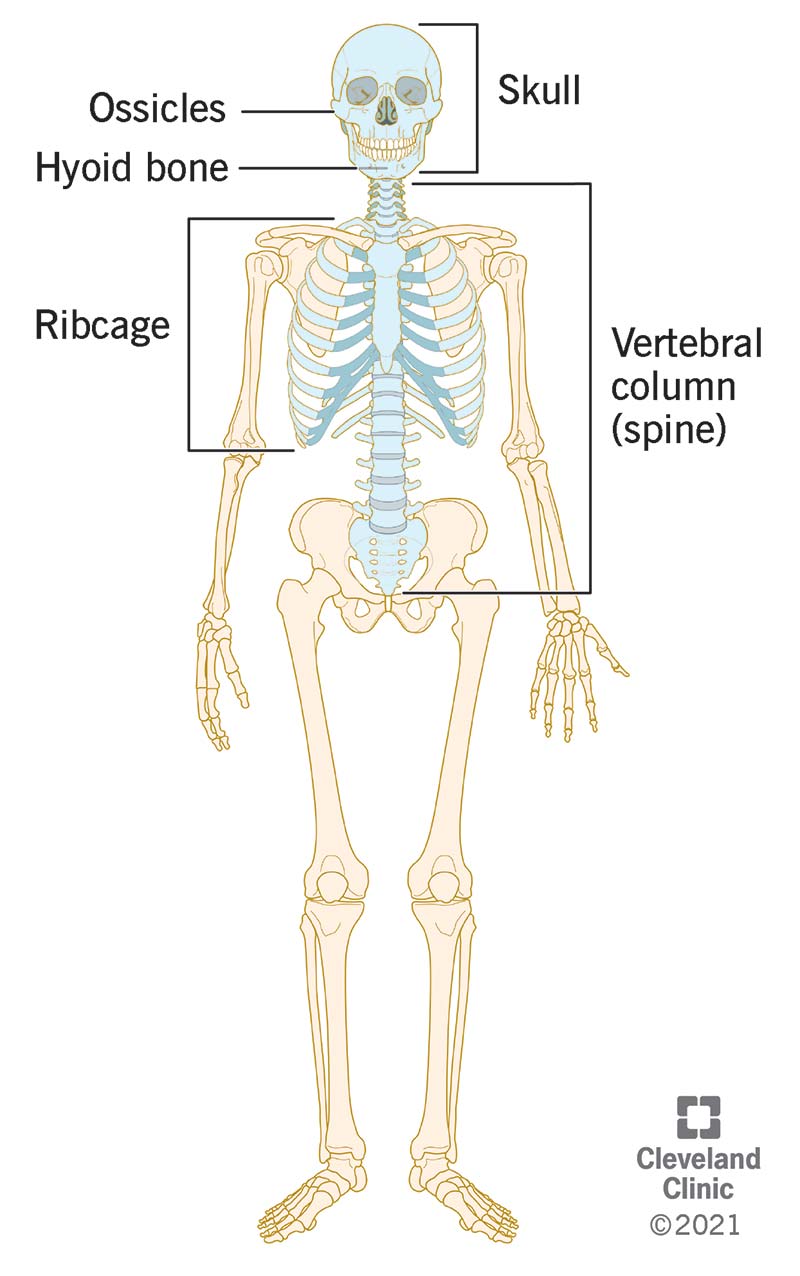Your axial skeleton is made up of the 80 bones within the central core of your body. This includes bones in your skull (cranial and facial bones), ears, neck, back (vertebrae, sacrum and tailbone) and ribcage (sternum and ribs). Your axial skeleton protects your brain, spinal cord, heart, lungs and other important organs.
Advertisement
Cleveland Clinic is a non-profit academic medical center. Advertising on our site helps support our mission. We do not endorse non-Cleveland Clinic products or services. Policy

The adult human body has 206 bones. These bones are divided into two main parts: Your appendicular skeleton and your axial skeleton. Your axial skeleton is made up of the bones along your vertical axis. Axial comes from the word “axis,” which means line. The bones line up along the central core of your body.
Advertisement
Cleveland Clinic is a non-profit academic medical center. Advertising on our site helps support our mission. We do not endorse non-Cleveland Clinic products or services. Policy
Your axial skeleton is made up of the bones in your head, neck, back and chest. Your appendicular skeleton is made up of everything else — the bones that attach (append) to your axial skeleton. Your appendicular skeleton includes the bones in your shoulders, pelvis and limbs, including your arms, hands, legs and feet.
Your axial skeleton provides support and cushioning for your brain, spinal cord and organs in your body. Muscles in your body that move your head, neck and trunk attach to your axial skeleton. These muscles help you breathe and steady parts of your appendicular skeleton.
Your axial skeleton is made up of 80 bones.
The five parts of your axial skeleton include the bones in your skull, ossicles (small bones) of your middle ear, hyoid bone of your neck, vertebra (bones of your spine) and thoracic cage (ribcage).
The axial skeleton includes bones in your skull, ears, neck, back and ribcage:
Your skull has two sets of bones: Eight cranial bones and 14 facial bones. The cranial bones make up the top and back of your skull and support and protect your brain. The eight cranial bones include:
Advertisement
The facial bones make up the face of your skull and form an entrance to your body. The 14 facial bones include:
The auditory ossicles (small bones) of your middle ear are the smallest bones in your body. These tiny bones transfer vibrations from your eardrum to your inner ear. The middle ear bones include:
The hyoid bone is a horseshoe-shaped bone that sits at the front of your neck. Muscles and ligaments hold it in place between your jaw bone and thyroid. Your hyoid bone helps you breathe, speak and swallow.
The vertebral column, or spine, includes 24 vertebrae plus your sacrum and your tailbone (coccyx). The vertebral column extends from the base of your skull to your pelvis. It’s grouped into five sections:
The thoracic cage, or ribcage, protects your heart, lungs and other organs. It attaches to muscles involved with breathing and arm movement. The bones in your ribcage include:
Many conditions can cause problems with your axial skeleton. Some develop due to wear and tear as you age. Others happen as a result of disease or injury. Conditions that may affect your axial skeleton include:
Advertisement
The best way to take care of your axial skeleton is to maintain a healthy lifestyle. To keep your bones strong and healthy:
Your axial skeleton is made up of the 80 bones within the central core of your body. This includes bones in your head, neck, back and chest. Your axial skeleton protects and cushions your brain, spinal cord and organs. Many different health conditions can affect your axial skeleton, so it’s important to keep it healthy and strong. By maintaining a healthy lifestyle, you should be able to lower your overall risk for disease and injury. By taking good care of yourself, you’ll be able to protect your bones so they can keep protecting you.
Advertisement
Cleveland Clinic’s primary care providers offer lifelong medical care. From sinus infections and high blood pressure to preventive screening, we’re here for you.

Last reviewed on 02/08/2022.
Learn more about the Health Library and our editorial process.